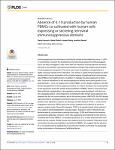Absence of IL-10 production by human PBMCs co-cultivated with human cells expressing or secreting retroviral immunosuppressive domains
Ivanusic, Daniel
Pietsch, Heiko
König, Jasper
Denner, Joachim
Immunosuppression by retroviruses including the human immunodeficiency virus—1 (HIV-1) is well known, however the mechanisms how retroviruses induce this immunosuppression is not fully investigated. It was shown that non-infectious retroviral particles as well as retroviral or recombinant retroviral transmembrane envelope (TM) proteins demonstrated immunosuppressive properties. The same was shown for peptides corresponding to a highly conserved domain in the TM protein. This domain is called immunosuppressive (ISU) domain and it induces modulation of the cytokine release of peripheral blood mononuclear cells (PBMCs) from healthy donors. In addition, it changes the gene expression of these cells. Common indications for the immunosuppressive activity were tumour growth in vivo and interleukin—10 (IL-10) release from human PBMCs in vitro. Single mutations in the ISU domain abrogated the immunosuppressive activity. In order to develop a new model system for the expression of the ISU domain and presentation to PBMCs which is not prone to possible endotoxin contaminations, two expression systems were developed. In the first system, designated pOUT, retroviral proteins containing the ISU domain were expressed and released into the cell culture medium, and in the second system, tANCHOR, the ISU domain was presented by a tetraspanin-anchored sequence on the cell surface of human cells. Both systems were exploited to express the wild-type (wt) ISU domains of HIV-1, of the porcine endogenous retrovirus (PERV) and of the murine leukaemia virus (MuLV) as well as to express mutants (mut) of these ISU domains. PERV is of special interest in the context of virus safety of xenotransplantation using pig organs. Expression of the TM proteins was demonstrated by confocal laser scanning microscopy, ELISA and Western blot analyses using specific antibodies. However, when cells expressing and releasing the ISU were co-incubated with human PBMCs, no increased production of IL-10 was observed when compared with the mutants. Similar results were obtained when the released TM proteins were concentrated by immunoprecipitation and added to PBMCs. We suggest that the absence of IL-10 induction can be explained by a low amount of protein, by the lack of a biologically active conformation or the absence of additional factors.
Dateien zu dieser Publikation

